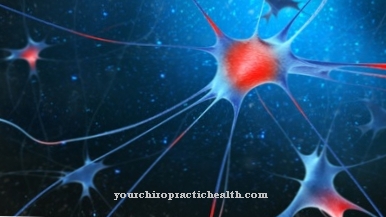Of the Gag reflex is a protective reflex that is supposed to prevent foreign bodies or liquids from accidentally entering the airways, objects that are too large or e.g. B. extremely bitter food is swallowed. The reflex is triggered by touching the base of the tongue and / or the soft palate, especially the palatal arches. The gag reflex is performed by a contraction of the muscles of the back of the throat.
What is the gag reflex?

The gag or gag reflex serves to protect the respiratory tract and the gastric tract from accidental penetration of foreign bodies. In the case of the trachea, the reflex prevents a solid body from entering. The purpose of the esophagus is to prevent accidental ingestion of a large object or very bitter or spoiled food that could indicate poison.
The gag reflex is assigned to the category of extraneous reflexes or multisynaptic reflexes because the trigger of the reflex is not also the effector. The reflex is triggered by touching the base of the tongue and / or the soft palate (soft palate), but not by touching the uvula. The execution, however, is done by the muscles of the back of the throat.
The vagus nerve and glossopharyngeal nerve are involved in the execution and coordination of the reflex. The glossopharyngeal nerve is also known as the 9th cranial nerve, which, in addition to somatosensitive nerve fibers, mainly carries visceromotor and viscerosensitive fibers. The vagus nerve is the 10th cranial nerve and is also composed of mixed somatosensitive, viscerosensitive and motoric fibers.
Function & task
One of the primary functions and tasks of the gag reflex is to protect the windpipe from foreign bodies or from obstruction and thus from suffocation. The simultaneous protection against accidental ingestion of large objects and spoiled or very bitter food, which could be poisonous, is also one of the primary tasks of the reflex.
The reflex is usually so strong that it works even when you are unconscious and is even used as one of several tests to determine brain death.
In addition to triggering the gag reflex through mechanical-physical contact stimuli of the soft palate or the base of the tongue, the reflex can also be generated mentally through feelings of disgust. In contrast to the innate “mechanical” trigger of the reflex, disgust is acquired through experience and ideas.
Traditional food bans or repeated negative experiences with the ingestion of certain foods can cause a strong aversion to the generation of the gag reflex with vomiting.
If the sight of certain food triggers a feeling of disgust, the sense of taste can also trigger the gag reflex if the "disgusting‘ "food accidentally gets into the mouth and only the taste buds notice it.
Also phobias, e.g. B. a spider phobia, which is actually triggered by fear, can cause a gag reflex. In a broader sense, the reflex therefore not only serves to provide immediate protection against suffocation and protection against mechanical hazards to the esophagus and stomach tracts as well as protection against possible poisoning, but also to serve certain foods that are subject to a social taboo avoid. The gag reflex thus also has an important social component.
You can find your medication here
➔ Medicines against vomiting and nauseaIllnesses & ailments
The most common problem associated with the gag reflex is over-sensitivity. It manifests itself in upcoming examinations of the mouth and throat or in dental treatments where the gag reflex occurs and is unpleasant and annoying for both sides, patient and doctor. The over-sensitization of the reflex can be so strong that the sight of the instrument that has to be inserted into the oral cavity can trigger nausea.
Another disturbance of the gag reflex can have various causes. Purely anatomical changes in the pharynx can be the cause of a malfunction of the reflex or neuronal problems that affect the 9th and 10th cranial nerves.
Neural problems can e.g. B. due to an accident with a lesion of the 9th or 10th cranial nerve, due to a stroke or a nervous disease.
The glossopharyngeal nerve, which is involved in the formation of the gag reflex, can trigger a so-called glossopharyngeal spasm. It is a spasm of the throat muscles, which is also responsible for the gag reflex. Such a cramp can be triggered by a rabies or tetanus infection, whereby tetanus and botulinum toxins can paralyze the nerve completely.
A third complex of causes for a disorder of the gag reflex lies in psychological disorders that can lead to over-sensitization. In this context, there is a classic conditioning of the reflex in a dental practice, when a patient z. B. a somewhat insensitive handling of an impression tray with too much impression material triggered a strong gag reflex that the patient could no longer suppress. In correspondingly sensitive patients, this can be sufficient for conditioning, i.e. strengthening the reflex.
Frequent passive or active triggering of the reflex can lead to a desensitization or complete standstill. A classic example are people with bulimia who often use the gag reflex to vomit.
A targeted desensitization on a psychological basis under the guidance of a therapist to return the gag reflex to a "normal level" can be useful. In the event of success, this avoids any dental treatment or any treatment that has to do with the mouth and throat becoming a problem with the need for calming down with a sedative or even the need for a short anesthetic. Targeted acupuncture treatment can also be used successfully for desensitization.



























